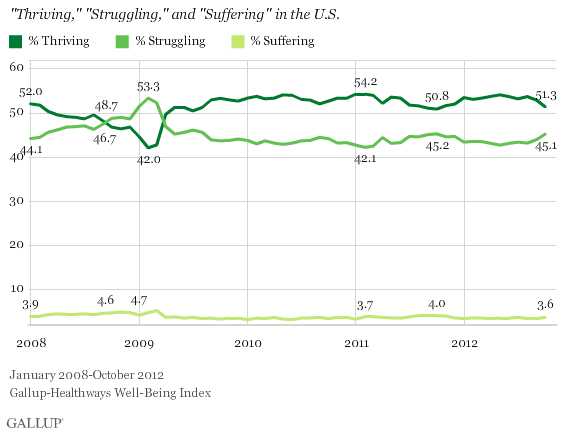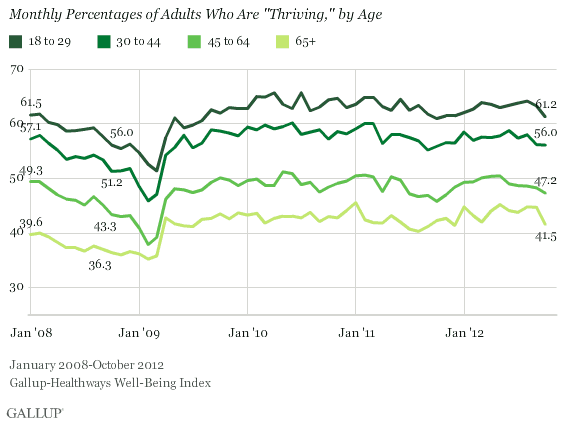WASHINGTON, D.C. -- As Americans cast their ballots Tuesday, their outlook on life was slightly improved from what it was four years ago. Now, more adults are thriving than struggling -- the opposite was true in October 2008. But, life ratings have been declining recently, with the 51.3% of Americans who are thriving down from the high of 54.2% found in January and February of last year.

Americans have been through a lot over the past four years: a grave financial crisis, a deep recession, a painful housing market, a troubling stock market ride, and a nearly disastrous government debt ceiling standoff. And their outlook on their lives has fluctuated in sync with these major economic and political disturbances.
By the time President Obama started his first full month in office in February 2009, the percentage of Americans who were struggling climbed to an all-time high of 53.3%, far outpacing the 42% who were thriving. But, Americans' life ratings bounced back later that year and have remained generally higher since. Still, Americans' life outlook is a long ways away from its best as President Obama readies for his second term in office, underscoring the challenges he faces.
Gallup classifies Americans as "thriving," "struggling," or "suffering" according to how they rate their current and future lives on a ladder scale with steps numbered from 0 to 10 based on the Cantril Self-Anchoring Striving Scale. Those who rate their present life a 7 or higher and their live in five years an 8 or higher are classified as thriving, while those who rate both dimensions a 4 or lower are considered suffering. Respondents whose ratings fall in between are considered struggling.
Americans of All Ages More Optimistic About Their Lives Now Than Four Years Ago
Americans young and old rate their lives better now than they did four years ago. But, life ratings for all age groups declined in October, revealing that whatever issues are causing Americans to be less optimistic about their lives recently are affecting everyone, regardless of age.
Still, young adults have consistently been more likely to report thriving in their lives than older adults, which continues to be true.

Bottom Line
Americans of all ages saw life as better now than they did four years ago as they prepared to vote in the 2008 presidential election. And, they apparently felt optimistic enough that President Obama could enhance their situations further in the next four years. But, as Obama finishes his first term and gears up for his second, Americans are feeling worse about their lives, meaning he will need to quickly lift the spirits of the country to help people believe their lives will get better.
About the Gallup-Healthways Well-Being Index
The Gallup-Healthways Well-Being Index tracks well-being in the U.S., U.K., and Germany and provides best-in-class solutions for a healthier world. To learn more, please visit well-beingindex.com.
Survey Methods
Results are based on telephone interviews conducted as part of the Gallup-Healthways Well-Being Index survey Oct. 1-31, 2012, with a random sample of 28,295 adults, aged 18 and older, living in all 50 U.S. states and the District of Columbia, selected using random-digit-dial sampling.
Life Evaluation Index figures from January 2008 to April 2009 reflect re-estimates calculated to address context effects that Gallup discovered after the data were originally published.
For results based on the total sample of national adults, one can say with 95% confidence that the maximum margin of sampling error is ±1 percentage point.
Interviews are conducted with respondents on landline telephones and cellular phones, with interviews conducted in Spanish for respondents who are primarily Spanish-speaking. Each sample includes a minimum quota of 400 cell phone respondents and 600 landline respondents per 1,000 national adults, with additional minimum quotas among landline respondents by region. Landline telephone numbers are chosen at random among listed telephone numbers. Cell phone numbers are selected using random-digit-dial methods. Landline respondents are chosen at random within each household on the basis of which member had the most recent birthday.
Samples are weighted by gender, age, race, Hispanic ethnicity, education, region, adults in the household, and phone status (cell phone only/landline only/both, cell phone mostly, and having an unlisted landline number). Demographic weighting targets are based on the March 2010 Current Population Survey figures for the aged 18 and older non-institutionalized population living in U.S. telephone households. All reported margins of sampling error include the computed design effects for weighting and sample design.
In addition to sampling error, question wording and practical difficulties in conducting surveys can introduce error or bias into the findings of public opinion polls.
For more details on Gallup's polling methodology, visit https://www.gallup.com/.
